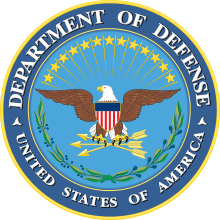United States Marine Corps
The United States Marine Corps (USMC) is a branch of the United States Armed Forces responsible for providing power projection,[7] using the mobility of the United States Navy, by Congressional mandate, to deliver rapidly, combined-arms task forces on land, at sea, and in the air. The U.S. Marine Corps is one of the four armed service branches in the U.S. Department of Defense (DoD) and one of the seven uniformed services of the United States. The current Chairman of the Joint Chiefs of Staff, the highest-ranking military officer in the U.S. armed forces, is a Marine Corps general.
The Marine Corps has been a component of the U.S. Department of the Navy since 30 June 1834,[8] working closely with naval forces for training, transportation, and logistics. The USMC operates posts on land and aboard sea-going amphibious warfare ships around the world. Additionally, several of the Marines' tactical aviation squadrons, primarily Marine Fighter Attack squadrons, are also embedded in Navy carrier air wings and operate from the Navy's nuclear-powered aircraft carriers.[9]
Two battalions of Continental Marines were formed on 10 November 1775 in Philadelphia as a service branch of infantry troops capable of fighting for independence both at sea and on shore.[10] The role of the Corps has since grown and evolved, expanding to aerial warfare and earning popular titles such as, "America's third air force", and, "second land army".[11] The United States Marine Corps has distinguished itself as it has served in the majority of American wars and armed conflicts, from its inception to the modern era, and attained prominence in the 20th century when its theories and practices of amphibious warfare proved prescient and ultimately formed the cornerstone of the Pacific theater of World War II.[12]
By the mid-20th century, the U.S. Marine Corps had become a major theorist of and the world's dominant practitioner of amphibious warfare.[13][14][15] Its ability to rapidly respond on short notice to expeditionary crises gives it a strong role in the implementation and execution of American foreign policy.[16] As of 2016, the USMC has around 182,000 active duty members and some 38,500 reserve Marines.[2] It is the smallest of the U.S. Armed Forces within the U.S. DoD.[17][18][19]
Mission
The USMC serves as an expeditionary force-in-readiness. As outlined in 10 U.S.C. § 5063 and as originally introduced under the National Security Act of 1947, it has three primary areas of responsibility:
- The seizure or defense of advanced naval bases and other land operations to support naval campaigns;
- The development of tactics, technique, and equipment used by amphibious landing forces in coordination with the Army and Air Force; and
- Such other duties as the President may direct.

This last clause, while seemingly redundant given the President's position as Commander-in-chief, is a codification of the expeditionary responsibilities of the Marine Corps. It derives from similar language in the Congressional acts "For the Better Organization of the Marine Corps" of 1834, and "Establishing and Organizing a Marine Corps" of 1798. In 1951, the House of Representatives' Armed Services Committee called the clause "one of the most important statutory – and traditional – functions of the Marine Corps." It noted that the Corps has more often than not performed actions of a non-naval nature, including its famous actions in Tripoli, the War of 1812, Chapultepec, and numerous counter-insurgency and occupational duties (such as those in Central America), World War I, and the Korean War. While these actions are not accurately described as support of naval campaigns nor as amphibious warfare, their common thread is that they are of an expeditionary nature, using the mobility of the Navy to provide timely intervention in foreign affairs on behalf of American interests.[20]
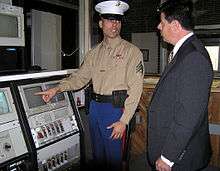
In addition to its primary duties, the Marine Corps conducts Visit, Board, Search, and Seizure (VBSS) operations, as well as missions in direct support of the White House and the State Department. The Marine Band, dubbed the "President's Own" by Thomas Jefferson, provides music for state functions at the White House.[21] Marines from Ceremonial Companies A & B, quartered in Marine Barracks, Washington, D.C., guard presidential retreats, including Camp David, and the Marines of the Executive Flight Detachment of HMX-1 provide helicopter transport to the President and Vice President, with the radio call signs "Marine One" and "Marine Two", respectively.[22] The Executive Flight Detachment also provides helicopter transport to Cabinet members and other VIPs. By authority of the 1946 Foreign Service Act, the Marine Security Guards of the Marine Embassy Security Command provide security for American embassies, legations, and consulates at more than 140 posts worldwide.[23] The relationship between the Department of State and the U.S. Marine Corps is nearly as old as the corps itself. For over 200 years, Marines have served at the request of various Secretaries of State. After World War II, an alert, disciplined force was needed to protect American embassies, consulates, and legations throughout the world. In 1947, a proposal was made that the Department of War furnish Marine Corps personnel for Foreign Service guard duty under the provisions of the Foreign Service Act of 1946. A formal Memorandum of Agreement was signed between the Department of State and the Secretary of the Navy on December 15, 1948, and 83 Marines were deployed to overseas missions. During the first year of the MSG program, 36 detachments were deployed worldwide.[24]
Historical mission
The Marine Corps was founded to serve as an infantry unit aboard naval vessels and was responsible for the security of the ship and its crew by conducting offensive and defensive combat during boarding actions and defending the ship's officers from mutiny; to the latter end, their quarters on ship were often strategically positioned between the officers' quarters and the rest of the vessel. Continental Marines manned raiding parties, both at sea and ashore. America's first amphibious assault landing occurred early in the Revolutionary War on 3 March 1776 as the Marines gained control of Fort Montague and Fort Nassau, a British ammunition depot and naval port in New Providence, the Bahamas. The role of the Marine Corps has expanded significantly since then; as the importance of its original naval mission declined with changing naval warfare doctrine and the professionalization of the naval service, the Corps adapted by focusing on formerly secondary missions ashore. The Advanced Base Doctrine of the early 20th century codified their combat duties ashore, outlining the use of Marines in the seizure of bases and other duties on land to support naval campaigns.
Throughout the late 19th and 20th centuries, Marine detachments served aboard Navy cruisers, battleships and aircraft carriers. Marine detachments (generally one platoon per cruiser, a company for battleships or carriers) served in their traditional duties as a ship's landing force, manning the ship's weapons and providing shipboard security. Marine detachments were augmented by members of the ship's company for landing parties, such as in the First Sumatran Expedition of 1832, and continuing in the Caribbean and Mexican campaigns of the early 20th centuries. Marines would develop tactics and techniques of amphibious assault on defended coastlines in time for use in World War II.[25] During World War II, Marines continued to serve on capital ships. They often were assigned to man anti-aircraft batteries. When gun cruisers were retired by the 1960s, the remaining Marine detachments were only seen on battleships and carriers. Its original mission of providing shipboard security finally ended in the 1990s as the battleships were retired and nuclear weapons were withdrawn from deployment on aircraft carriers.
Capabilities
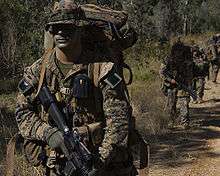
The Marine Corps fulfills a vital role in national security as an amphibious, expeditionary, air-ground combined arms task force, capable of forcible entry from the air, land, and sea. It is capable of asymmetric warfare with conventional, irregular, and hybrid forces.
While the Marine Corps does not employ any unique combat arms, as a force it can rapidly deploy a combined-arms task force to almost anywhere in the world within days. The basic structure for all deployed units is a Marine Air-Ground Task Force (MAGTF) that integrates a ground combat element, an aviation combat element and a logistics combat element under a common command element. While the creation of joint commands under the Goldwater–Nichols Act has improved inter-service coordination between each branch, the Corps' ability to permanently maintain integrated multi-element task forces under a single command provides a smoother implementation of combined-arms warfare principles.[12]
The close integration of disparate Marine units stems from an organizational culture centered on the infantry. Every other Marine capability exists to support the infantry. Unlike some Western militaries, the Corps remained conservative against theories proclaiming the ability of new weapons to win wars independently. For example, Marine aviation has always been focused on close air support and has remained largely uninfluenced by air power theories proclaiming that strategic bombing can single-handedly win wars.[25]

This focus on the infantry is matched with the doctrine of "Every Marine [is] a rifleman", a focus of Commandant Alfred M. Gray, Jr., emphasizing the infantry combat abilities of every Marine. All Marines, regardless of military specialization, receive training as a rifleman; and all officers receive additional training as infantry platoon commanders.[26] For example, at Wake Island, when all of the Marine aircraft were shot down, pilots continued the fight as ground officers, leading supply clerks and cooks in a final defensive effort.[27] As a result, a large degree of initiative and autonomy is expected of junior Marines, particularly the NCOs (corporals and sergeants), as compared with many other military organizations. The Marine Corps emphasizes authority and responsibility downward to a greater degree than the other military services. Flexibility of execution is implemented via an emphasis on "commander's intent" as a guiding principle for carrying out orders; specifying the end state but leaving open the method of execution.[28]
The amphibious assault techniques developed for World War II evolved, with the addition of air assault and maneuver warfare doctrine, into the current "Operational Maneuver from the Sea" doctrine of power projection from the seas.[7] The Marines are credited with the development of helicopter insertion doctrine and were the earliest in the American military to widely adopt maneuver-warfare principles which emphasize low-level initiative and flexible execution. In light of recent warfare that has strayed from the Corps' traditional missions,[29] it has renewed an emphasis on amphibious capabilities.[30]

The Marine Corps relies on the Navy for sealift to provide its rapid deployment capabilities. In addition to basing a third of the Fleet Marine Force in Japan, Marine Expeditionary Units (MEU) are typically stationed at sea. This allows the ability to function as first responders to international incidents. The United States Army maintains light infantry units capable of rapid worldwide deployment, but those units do not match the combined-arms integration of an MAGTF and lack the logistics that the Navy provides.[12] Therefore, the Marine Corps is often assigned to non-combat missions such as the evacuation of Americans from unstable countries and providing humanitarian relief during natural disasters. In larger conflicts, Marines act as a stopgap, to get into and hold an area until larger units can be mobilized. The Corps performed this role in World War I and the Korean War, where Marines were the first significant combat units deployed from the United States and held the line until the country could mobilize for war.[31] To aid rapid deployment, the Maritime Pre-Positioning System was developed: fleets of container ships are positioned throughout the world with enough equipment and supplies for a Marine Expeditionary Force to deploy for 30 days.
The USMC is planning to reduce its logistical requirements and by 2025 eliminate all liquid fuel use for Marine Expeditionary Forces, except for highly efficient vehicles.[32]
Doctrine
Two small manuals published during the 1930s would establish USMC doctrine in two areas. The Small Wars Manual laid the framework for Marine counter-insurgency operations from Vietnam to Iraq and Afghanistan while the Tentative Landing Operations Manual established the doctrine for the amphibious operations of World War II. "Operational Maneuver from the Sea" is the current doctrine of power projection.[7]
History
Origins
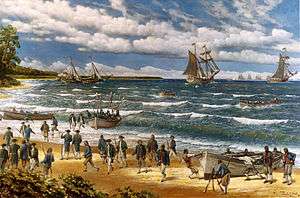
The United States Marine Corps traces its institutional roots to the Continental Marines of the American Revolutionary War, formed by Captain Samuel Nicholas by a resolution of the Second Continental Congress on 10 November 1775, to raise two battalions of Marines. That date is regarded and celebrated as the date of the Marine Corps' birthday. At the end of the American Revolution, both the Continental Navy and Continental Marines were disbanded in April 1783. The institution itself would not be resurrected until 11 July 1798. At that time, in preparation for the Quasi-War with France, Congress created the United States Marine Corps.[33] Marines had been enlisted by the War Department as early as August 1797[34] for service in the new-build frigates authorized by the Congressional "Act to provide a Naval Armament" of 18 March 1794,[35] which specified the numbers of Marines to be recruited for each frigate.
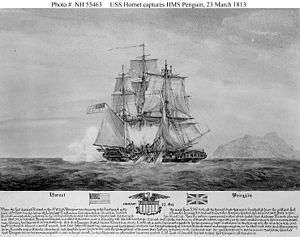
The Marines' most famous action of this period occurred during the First Barbary War (1801–1805) against the Barbary pirates,[36] when William Eaton and First Lieutenant Presley O'Bannon led eight Marines and 500 mercenaries in an effort to capture Tripoli. Though they only reached Derna, the action at Tripoli has been immortalized in the Marines' hymn and the Mameluke Sword carried by Marine officers.[37]
During the War of 1812, Marine naval detachments took part in some of the great frigate duels that characterized the war, which were the first and last engagements of the conflict. Their most significant contribution, however, was holding the center of General Jackson's defensive line at the Battle of New Orleans, the final major battle and most one-sided engagement of the war. With widespread news of the battle and the capture of the HMS Cyane, HMS Levant and HMS Penguin, the final engagements between British and American forces, the Marines had acquired a well-deserved reputation as expert marksmen, especially in defensive and ship-to-ship actions.[37]
After the war, the Marine Corps fell into a malaise that ended with the appointment of Archibald Henderson as its fifth Commandant in 1820. Under his tenure, the Corps took on expeditionary duties in the Caribbean, the Gulf of Mexico, Key West, West Africa, the Falkland Islands, and Sumatra. Commandant Henderson is credited with thwarting President Jackson's attempts to combine and integrate the Marine Corps with the Army.[37] Instead, Congress passed the Act for the Better Organization of the Marine Corps in 1834, stipulating that the Corps was part of the Department of the Navy as a sister service to the Navy.[38] This would be the first of many times that the existence of the Corps was challenged.
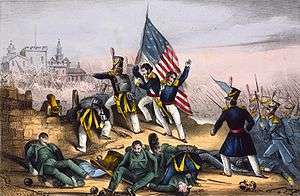
Commandant Henderson volunteered the Marines for service in the Seminole Wars of 1835, personally leading nearly half of the entire Corps (two battalions) to war. A decade later, in the Mexican–American War (1846–1848), the Marines made their famed assault on Chapultepec Palace in Mexico City, which would be later celebrated by the phrase "From The Halls of Montezuma" in Marines' hymn. In the 1850s, the Marines would see further service in Panama and Asia, escorting Matthew Perry's East India Squadron on its historic trip to the Far East.[39]
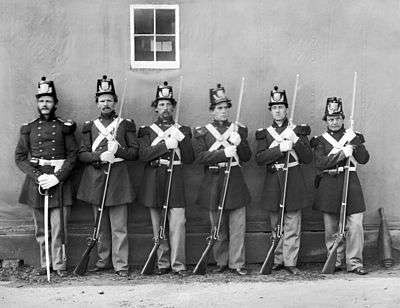
With their vast service in foreign engagements, the Marine Corps played a moderate role in the Civil War (1861–1865); their most prominent task was blockade duty. As more and more states seceded from the Union, about a third of the Corps' officers left the Union to join the Confederacy and form the Confederate States Marine Corps, which ultimately played little part in the war. The battalion of recruits formed for the First Battle of Bull Run (First Manassas) performed poorly, retreating with the rest of the Union forces.[31] Blockade duty included sea-based amphibious operations to secure forward bases. In late November 1861, Marines and sailors landed a reconnaissance in force from the USS Flag at Tybee Island, Georgia, to occupy the Lighthouse and Martello Tower on the northern end of the island. It would later be the Army base for bombardment of Fort Pulaski.[40]
American Civil War to World War I
The remainder of the 19th century was marked by declining strength and introspection about the mission of the Marine Corps. The Navy's transition from sail to steam put into question the need for Marines on naval ships. Meanwhile, Marines served as a convenient resource for interventions and landings to protect American lives and interests overseas. The Corps was involved in over 28 separate interventions in the 30 years from the end of the American Civil War to the end of 19th century, with 148 U.S. Marines killed in action fighting against the Confederates in the U.S. Civil War.[41] They would be called upon to stem political and labor unrest within the United States.[42] Under Commandant Jacob Zeilin's tenure, Marine customs and traditions took shape: the Corps adopted the Marine Corps emblem on 19 November 1868. It was during this time that "The Marines' Hymn" was first heard. Around 1883, the Marines adopted their current motto "Semper Fidelis" (Always Faithful).[37]
John Philip Sousa, the musician and composer, enlisted as a Marine apprentice at the age of 13, serving from 1867 until 1872, and again from 1880 to 1892 as the leader of the Marine Band. During the Spanish–American War (1898), Marines led American forces ashore in the Philippines, Cuba, and Puerto Rico, demonstrating their readiness for deployment. At Guantánamo Bay, Cuba, the Marines seized an advanced naval base that remains in use today. Between 1899 and 1916, the Corps continued its record of vigorous participation in foreign expeditions, including the Philippine–American War, the Boxer Rebellion in China (1899–1901), Panama, the Cuban Pacifications, the Perdicaris Incident in Morocco, Veracruz, Santo Domingo, and the Banana Wars in Haiti and Nicaragua; the experiences gained in counter-insurgency and guerrilla operations during this period were consolidated into the Small Wars Manual.[43]
World War I
.png)
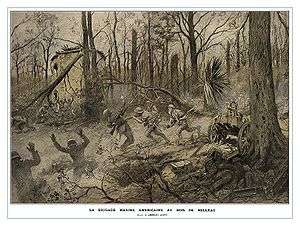
During World War I veteran Marines served a central role in the late American entry into the conflict, on 6 April 1917. The Marine Corps had a deep pool of officers and NCOs with battle experience, and experienced a small expansion. During the war, the Marines, fighting on the Western Front in France, fought their famed battle at Belleau Wood, creating the Marines' reputation in modern history. While its previous expeditionary experiences had not earned it much acclaim in the Western world, the Marines' ferocity and toughness in France earned them the respect of the Germans. Though Marines and American media reported that Germans had nicknamed them Teufel Hunden as meaning "Devil Dogs", for their reputation as shock troops and marksmen at ranges up to 900 meters, there is no evidence of this in German records (as Teufelshunde would be the proper German phrase). Nevertheless, the name stuck.[44]

The Corps entered the war with 511 officers and 13,214 enlisted personnel, and by 11 November 1918 had reached a strength of 2,400 officers and 70,000 enlisted.[45] African-Americans were entirely excluded from the Marine Corps during this conflict.[46] Opha May Johnson was the first woman to enlist in the Marines; she joined the Marine Corps Reserve in 1918 during World War I, officially becoming the first female Marine.[47] From then until the end of World War I, 305 women enlisted in the Corps.[48]
Between the World Wars, the Marine Corps was headed by Commandant John A. Lejeune, and under his leadership, the Corps presciently studied and developed amphibious techniques that would be of great use in World War II. Many officers, including Lieutenant Colonel Earl Hancock "Pete" Ellis, foresaw a war in the Pacific with Japan and undertook preparations for such a conflict. Through 1941, as the prospect of war grew, the Corps pushed urgently for joint amphibious exercises and acquired amphibious equipment that would prove of great use in the upcoming conflict.[49]
World War II

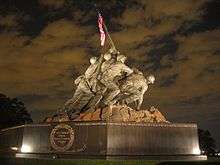
.
In World War II, the Marines played a central role in the Pacific War. The battles of Guadalcanal, Bougainville, Tarawa, Guam, Tinian, Cape Gloucester, Saipan, Peleliu, Iwo Jima, and Okinawa saw fierce fighting between Marines and the Imperial Japanese Army.
The island of Iwo Jima served as the next area of battle, which began on 19 February 1945. The Japanese had learned from their defeats in the Marianas campaign and prepared many fortified positions on the island, including pillboxes and underground tunnels. The Japanese put up fierce resistance, but American forces reached the summit of Mount Suribachi on 23 February. The mission was accomplished at very high losses, with 26,000 American casualties and 22,000 Japanese.[50]
By the end of the war, the Corps expanded from two brigades to six divisions, five air wings, and supporting troops, totaling about 485,000 Marines. In addition, 20 defense battalions and a parachute battalion were set raised.[51] Nearly 87,000 Marines were casualties during World War II (including nearly 20,000 killed), and 82 were awarded the Medal of Honor.[52]
Despite Secretary Forrestal's prediction, the Corps faced an immediate institutional crisis following the war due to the low budget. Army generals pushing for a strengthened and reorganized defense establishment attempted to fold the Marine mission and assets into the Navy and Army. Drawing on hastily assembled Congressional support, and with the assistance of the so-called "Revolt of the Admirals", the Marine Corps rebuffed such efforts to dismantle the Corps, resulting in statutory protection of the Marine Corps in the National Security Act of 1947.[53] Shortly afterward, in 1952 the Douglas–Mansfield Act afforded the Commandant an equal voice with the Joint Chiefs of Staff on matters relating to the Marines and established the structure of three active divisions and air wings that remain today.
Korean War
The Korean War (1950–1953) saw the hastily formed Provisional Marine Brigade holding the defensive line at the Pusan Perimeter. To execute a flanking maneuver, General Douglas MacArthur called on Marine air and ground forces to make an amphibious landing at Inchon. The successful landing resulted in the collapse of North Korean lines and the pursuit of North Korean forces north near the Yalu River until the entrance of the People's Republic of China into the war. Chinese troops surrounded, surprised and overwhelmed the overextended and outnumbered American forces. X Corps, which included the 1st Marine Division and the Army's 7th Infantry Division, regrouped and inflicted heavy casualties during their fighting withdrawal to the coast, now known as the Battle of Chosin Reservoir.
The fighting calmed after the Battle of the Chosin Reservoir, but late in March 1953 the relative quiet of the war was broken when the Chinese Army launched a massive offensive on three outposts manned by the 5th Marine Regiment. These outposts were codenamed "Reno", "Vegas", and "Carson". The campaign was collectively known as the Nevada Cities Campaign. There was brutal fighting on Reno hill, which was eventually captured by the Chinese. Although Reno was lost, the 5th Marines held both Vegas and Carson through the rest of the campaign. In this one campaign, the Marines suffered approximately 1,000 casualties, while the Chinese suffered at least twice as many. Marines would continue a battle of attrition around the 38th Parallel until the 1953 armistice.[54]
The Korean War saw the Corps expand from 75,000 regulars to a force of 261,000 Marines, mostly reservists. 30,544 Marines were killed or wounded during the war and 42 were awarded the Medal of Honor.[55]
Vietnam War
_001.jpg)
The Marine Corps served an important role in the Vietnam War taking part in such battles as the Battle of Hue and the Battle of Khe Sanh in 1968. Individuals from the USMC generally operated in the Northern I Corps Regions of South Vietnam. While there, they were constantly engaged in a guerrilla war against the Viet Cong, along with an intermittent conventional war against the North Vietnamese Army (NVA). Portions of the Corps were responsible for the less-known Combined Action Program (CAP) that implemented unconventional techniques for counter-insurgency and worked as military advisers to the Republic of Vietnam Marine Corps. Marines were withdrawn in 1971, and returned briefly in 1975 to evacuate Saigon and attempt a rescue of the crew of the Mayagüez.[56]
Vietnam was the longest war for Marines; by its end, 13,091[57][58] had been killed in action, 51,392 had been wounded, and 57 Medals of Honor had been awarded.[59][60] Due to policies concerning rotation, more Marines were deployed for service during Vietnam than World War II.[61]
While recovering from Vietnam, the Corps hit a detrimental low point in its service history caused by courts-martial and non-judicial punishments related partially to increased unauthorized absences and desertions during the war. Overhauling of the Corps began in the late 1970s, discharging the most delinquent, and once quality of new recruits improved, the Corps focused on reforming the NCO Corps, a vital functioning part of its forces.[12]
Interim: Vietnam War to the War on Terrorism
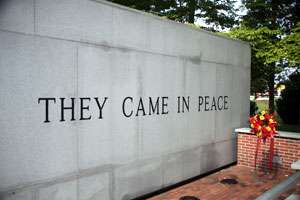
After the Vietnam War, the U.S. Marines resumed their expeditionary role, participating in the failed 1980 Iran hostage rescue attempt Operation Eagle Claw, the invasion of Grenada (Operation Urgent Fury) and the invasion of Panama (Operation Just Cause). On 23 October 1983, the Marine headquarters building in Beirut, Lebanon, was bombed, causing the highest peacetime losses to the Corps in its history (220 Marines and 21 other service members were killed) and leading to the American withdrawal from the country. The year 1990 saw Marines of the Joint Task Force Sharp Edge save thousands of lives by evacuating British, French and American nationals from the violence of the Liberian Civil War.
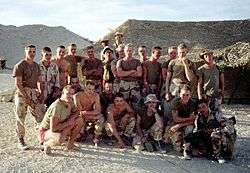
During the Gulf War (1990–1991), Marine task forces formed the initial core for Operation Desert Shield, while United States and Coalition troops mobilized, and later liberated Kuwait in Operation Desert Storm.[37] Marines participated in combat operations in Somalia (1992–1995) during Operations Restore Hope, Restore Hope II, and United Shield to provide humanitarian relief.[62] In 1997, Marines took part in Operation Silver Wake, the evacuation of American citizens from the US Embassy in Tirana, Albania.
Global War on Terrorism

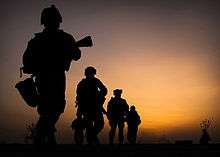
Following the attacks on 11 September 2001, President George W. Bush announced the Global War on Terrorism. The stated objective of the Global War on Terror is "the defeat of Al-Qaeda, other terrorist groups and any nation that supports or harbors terrorists."[63] Since then, the Marine Corps, alongside other military and federal agencies, has engaged in global operations around the world in support of that mission.
In spring 2009, President Barack Obama's goal of reducing spending in the Defense Department was led by Secretary Robert Gates in a series of budget cuts which did not result in significant changes in the Corps' budget and programs, cutting only the VH-71 Kestrel and resetting the VXX program.[64][65][66] However, the National Commission on Fiscal Responsibility and Reform singled the Corps out for the brunt of a series of recommended cuts in late 2010.[67] In light of budget sequestration in 2013, commandant Amos set a goal of a force of 174,000 Marines.[68] He testified that this was the minimum number that would allow for an effective response to even a single contingency operation, but it would reduce the peacetime ratio of time at home bases to time deployed down to a historical low level.[69]
Afghanistan Campaign (Operation Enduring Freedom-Afghanistan)
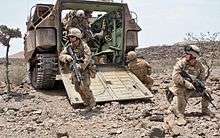
Marines and other American forces began staging in Pakistan and Uzbekistan on the border of Afghanistan as early as October 2001 in preparation for Operation Enduring Freedom.[70] The 15th and 26th Marine Expeditionary Units were the first conventional forces into Afghanistan in support of Operation Enduring Freedom in November 2001, and in December, the Marines seized Kandahar International Airport.[71] Since then, Marine battalions and squadrons have been rotating through, engaging Taliban and Al-Qaeda forces. Marines of the 24th Marine Expeditionary Unit flooded into the Taliban-held town of Garmsir on 29 April 2008, in Helmand Province, in the first major American operation in the region in years.[72] In June 2009, 7,000 Marines with the 2nd Marine Expeditionary Brigade deployed to Afghanistan in an effort to improve security,[73] and began Operation Strike of the Sword the next month. In February 2010, the 2nd Marine Expeditionary Brigade launched the largest offensive of the Afghan Campaign since 2001, the Battle of Marjah, to clear the Taliban from their key stronghold in Helmand Province.[74] After Marjah, Marines progressed north up the Helmand River and cleared the towns of Kajahki and Sangin. Marines remained in Helmand Province until 2014.
Iraq Campaign (Operation Iraqi Freedom, Operation New Dawn, Operation Inherent Resolve)
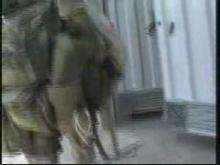
The U.S. Marines served prominently in the Iraq War's Operation Iraqi Freedom. The I Marine Expeditionary Force, along with the U.S. Army's 3rd Infantry Division, spearheaded the 2003 invasion of Iraq.[75] The Marines left Iraq in the summer of 2003, but returned for occupation duty in the beginning of 2004. They were given responsibility for the Al Anbar Province, the large desert region to the west of Baghdad. During this occupation, the Marines spearheaded both assaults on the city of Fallujah in April (Operation Vigilant Resolve) and November 2004 (Operation Phantom Fury) and saw intense fighting in such places as Ramadi, Al-Qa'im and Hīt.[76] Their time in Iraq has courted controversy with the Haditha killings and the Hamdania incident.[77][78] The Anbar Awakening and 2007 surge reduced levels of violence. On 1 March 2009, at Camp Lejeune, President Obama announced an accelerated withdrawal, promising all troops out by August 2010.[79] The Marine Corps officially ended its role in Iraq on 23 January 2010 when they handed over responsibility for Al Anbar Province to the United States Army.[79][80] US Marines would ultimately return to Iraq in the summer of 2014, in response to growing violence there.[81]
Horn of Africa Operations
Throughout the Global War on Terrorism, the US Marines have supported operations in Africa to counter Islamic extremism and piracy in the Red Sea. In late 2002, Combined Joint Task Force – Horn of Africa was stood up at Camp Lemonnier, Djibouti to provide regional security.[82] Despite transferring overall command to the Navy in 2006, the Marines continued to operate in the Horn of Africa into 2007.[83] See Operation Enduring Freedom- Horn of Africa.
Organization
Department of the Navy and the U.S. Marine Corps
The Department of the Navy, led by the Secretary of the Navy, is the service-level department of the cabinet-level U.S. Department of Defense that oversees the Marine Corps and the Navy. The most senior Marine officer is the Commandant, responsible to the Secretary of the Navy for organizing, recruiting, training, and equipping the Marine Corps so that its forces are ready for deployment under the operational command of the Combatant Commanders. The Marine Corps is organized into four principal subdivisions: Headquarters Marine Corps (HQMC), the Operating Forces, the Supporting Establishment, and the Marine Forces Reserve (MARFORRES or USMCR).
Headquarters Marine Corps (HQMC)
Headquarters Marine Corps consists of the Commandant of the Marine Corps, the Assistant Commandant of the Marine Corps, the Director Marine Corps Staff, the several Deputy Commandants, the Sergeant Major of the Marine Corps, and various special staff officers and Marine Corps agency heads that report directly to either the Commandant or Assistant Commandant. HQMC is supported by the Headquarters and Service Battalion, USMC providing administrative, supply, logistics, training, and services support to the Commandant and his staff.
Operating Forces
The Operating Forces are divided into three categories: Marine Corps Forces (MARFOR) assigned to unified commands (viz., the Fleet Marine Forces (FMF), Security Forces guarding high-risk naval installations, and Security Guard detachments at American embassies. Under the "Forces for Unified Commands" memo, in accordance with the Unified Command Plan approved by the President, Marine Corps Forces are assigned to each of the Combatant Commands at the discretion of the Secretary of Defense. Since 1991, the Marine Corps has maintained component headquarters at each of the regional unified combatant commands.[84]
Marine Corps Forces are divided into Forces Command (MARFORCOM) and Pacific Command (MARFORPAC), each headed by a Lieutenant General dual-posted as the commanding general of either FMF Atlantic (FMFLANT) or FMF Pacific (FMFPAC), respectively. MARFORCOM/FMFLANT has operational control of the II Marine Expeditionary Force; MARFORPAC/FMFPAC has operational control of the I Marine Expeditionary Force and III Marine Expeditionary Force.[31]
Marine Air-Ground Task Force (MAGTF)
The basic framework for deployable Marine units is the Marine Air-Ground Task Force (MAGTF), a flexible structure of varying size. A MAGTF integrates a ground combat element (GCE), an aviation combat element (ACE), and a logistics combat element (LCE) under a common command element (CE), capable of operating independently or as part of a larger coalition. The MAGTF structure reflects a strong tradition in the Corps towards self-sufficiency and a commitment to combined arms, both essential assets to an expeditionary force often called upon to act independently in discrete, time-sensitive situations. The history of the Marine Corps as well has led to a wariness of over reliance on its sister services, and towards joint operations in general.[12]
Supporting Establishment
The Supporting Establishment includes the Combat Development Command, the Logistics Command, the Systems Command, the Recruiting Command, the Installations Command, and the Marine Band.
Marine Corps bases and stations
The Marine Corps operates many major bases, 14 of which host operating forces, several support and training installations, as well as satellite facilities.[85] Marine Corps' bases are concentrated around the locations of the Marine Expeditionary Forces, though reserve units are scattered throughout the United States. The principal bases are Camp Pendleton on the West Coast, home to I MEF; Camp Lejeune on the East Coast, home to II MEF; and Camp Butler in Okinawa, Japan, home to III MEF.
Other important bases include air stations, recruit depots, logistics bases, and training commands. Marine Corps Air Ground Combat Center Twentynine Palms in California is the Marine Corps' largest base and home to the Corps' most complex, combined-arms, live-fire training. Marine Corps Base Quantico in Virginia is home to Marine Corps Combat Development Command, and nicknamed the "Crossroads of the Marine Corps".[86][87]
The Marine Corps maintains a significant presence in the National Capital Region, with Headquarters Marine Corps scattered amongst the Pentagon, Henderson Hall, Washington Navy Yard, and Marine Barracks, Washington, D.C. Additionally, Marines operate detachments at many installations owned by other branches, to better share resources, such as specialty schools. Marines are also present at, and operate many, forward bases during expeditionary operations.
Marine Forces Reserve (MARFORRES/USMCR)
Marine Forces Reserve consists of the Force Headquarters Group, 4th Marine Division, 4th Marine Aircraft Wing, and the 4th Marine Logistics Group. The MARFORRES/USMCR is capable of forming a 4th Marine Expeditionary Force (MEF) or reinforcing/augmenting active-duty forces.
Special Operations
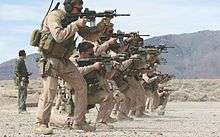
Marine Corps Forces Special Operations Command (MARSOC) includes: the Marine Raider Regiment, the Marine Raider Support Group, and the Marine Special Operations School. Both the Raider Regiment and the Raider Support Group consist of a headquarters company and three operations battalions. The Special Operations School conducts screening, assessment, selection, training and development functions for MARSOC units.
Marine Corps Special Operations Capable forces include: Air Naval Gunfire Liaison Companies, the Chemical Biological Incident Response Force, the Marine Division Reconnaissance Battalions, Force Reconnaissance Companies, Maritime Special Purpose Force, and Special Reaction Teams. Additionally, all deployed Marine Expeditionary Units are certified as "Special Operations Capable", viz. "MEU(SOC)".
Although the notion of a Marine special forces contribution to the United States Special Operations Command (USSOCOM) was considered as early as the founding of USSOCOM in the 1980s, it was resisted by the Marine Corps. Then-Commandant Paul X. Kelley expressed the popular belief that Marines should support Marines, and that the Corps should not fund a special operations capability that would not support Marine operations.[88] However, much of the resistance from within the Corps dissipated when Marine leaders watched the Corps' 15th and 26th MEU(SOC)s "sit on the sidelines" during the very early stages of Operation Enduring Freedom while other special operations units actively engaged in operations in Afghanistan.[89] After a three-year development period, the Corps agreed in 2006 to supply a 2,500-strong unit, Marine Forces Special Operations Command, which would answer directly to USSOCOM.[90]
Personnel
Leadership
As stated above, the Commandant of the Marine Corps is the highest-ranking officer of the Marine Corps; though he may not be the senior officer by time in grade and/or position of office. He is both the symbolic and functional head of the Corps, and holds a position of very high esteem among Marines. The Commandant has the U.S. Code Title 10 responsibility to man, train, and equip the Marine Corps. He does not serve as a direct battlefield commander. The Commandant is a member of the Joint Chiefs of Staff, and reports to the Secretary of the Navy.[91]
The Assistant Commandant of the Marine Corps acts as a deputy to the Commandant. The Sergeant Major of the Marine Corps is the senior enlisted Marine, and acts as an adviser to the Commandant. Headquarters Marine Corps comprises the rest of the Commandant's counsel and staff, with deputy Commandants that oversee various aspects of the Corps assets and capabilities.
The current and 37th Commandant is Robert Neller, who assumed the position on 30 September 2015.[92][93] The 33rd and current Assistant Commandant is John M. Paxton, Jr.,[94] while the 18th and current Sergeant Major is Ronald L. Green. Other Marine generals may be senior to the Commandant or Assistant Commandant in terms of time in grade and/or billet.
Rank structure
As in the rest of the United States military, Marine Corps ranks fall into one of three categories: commissioned officer, warrant officer, and enlisted, in decreasing order of authority (excluding the Air Force, which does not currently appoint warrant officers). To standardize compensation, each rank is assigned a pay grade.[95]
Commissioned officers
Commissioned officers are distinguished from other officers by their commission, which is the formal written authority, issued in the name of the President of the United States, that confers the rank and authority of a Marine officer. Commissioned officers carry the "special trust and confidence" of the President of the United States.[20] Marine Corps commissioned officers are promoted based on an "up or out" system in accordance with the Defense Officer Personnel Management Act of 1980.
| U.S. DoD Pay Grade | O-1 | O-2 | O-3 | O-4 | O-5 | O-6 | O-7 | O-8 | O-9 | O-10 |
|---|---|---|---|---|---|---|---|---|---|---|
| Insignia |  |
 |
 |
|||||||
| Title | Second Lieutenant | First Lieutenant | Captain | Major | Lieutenant Colonel | Colonel | Brigadier General | Major General | Lieutenant General | General |
| Abbreviation | 2ndLt | 1stLt | Capt | Maj | LtCol | Col | BGen | MajGen | LtGen | Gen |
| NATO Code | OF-1 | OF-2 | OF-3 | OF-4 | OF-5 | OF-6 | OF-7 | OF-8 | OF-9 | |
Warrant officers
Warrant officers are primarily former enlisted experts in a specific specialized field and provide leadership generally only within that speciality.
| U.S. DoD Pay Grade | W-1 | W-2 | W-3 | W-4 | W-5 |
|---|---|---|---|---|---|
| Insignia | |||||
| Title | Warrant Officer 1 | Chief Warrant Officer 2 | Chief Warrant Officer 3 | Chief Warrant Officer 4 | Chief Warrant Officer 5 |
| Abbreviation | WO | CWO2 | CWO3 | CWO4 | CWO5 |
| NATO Code | WO-1 | WO-2 | WO-3 | WO-4 | WO-5 |
Enlisted
Enlisted Marines in the pay grades E-1 to E-3 make up the bulk of the Corps' ranks, usually referred to simply as "Marines". Although they do not technically hold leadership ranks, the Corps' ethos stresses leadership among all Marines, and junior Marines are often assigned responsibility normally reserved for superiors. Those in the pay grades of E-4 and E-5 are non-commissioned officers (NCOs). They primarily supervise junior Marines and act as a vital link with the higher command structure, ensuring that orders are carried out correctly. Marines E-6 and higher are Staff Non-Commissioned Officers (SNCOs), charged with supervising NCOs and acting as enlisted advisers to the command.
The E-8 and E-9 levels have two and three ranks per pay grade, respectively, each with different responsibilities. The First Sergeant and Sergeant Major ranks are command-oriented, serving as the senior enlisted Marines in a unit, charged to assist the commanding officer in matters of discipline, administration and the morale and welfare of the unit. Master Sergeants and Master Gunnery Sergeants provide technical leadership as occupational specialists in their specific MOS. The Sergeant Major of the Marine Corps also E-9, is a billet conferred on the senior enlisted Marine of the entire Marine Corps, personally selected by the Commandant. It is possible however for an enlisted Marine to hold a position senior to Sergeant Major of the Marine Corps as has been the case since the 2011 appointment of Sergeant Major Bryan B. Battaglia to the billet of Senior Enlisted Advisor to the Chairman which is deemed the senior enlisted member of the United States military.
Different forms of address can be found at United States Marine Corps rank insignia and List of United States Marine Corps acronyms and expressions.
| U.S. DoD Pay grade | E-1 | E-2 | E-3 | E-4 | E-5 | E-6 | E-7 | E-8 | E-9 | ||||
|---|---|---|---|---|---|---|---|---|---|---|---|---|---|
| Insignia | No insignia |  |
 |
 |
 |
 |
 |
 |
 |
 | |||
| Title | Private | Private First Class |
Lance Corporal |
Corporal | Sergeant | Staff Sergeant |
Gunnery Sergeant |
Master Sergeant |
First Sergeant |
Master Gunnery Sergeant |
Sergeant Major |
Sergeant Major of the Marine Corps | |
| Abbreviation | Pvt | PFC | LCpl | Cpl | Sgt | SSgt | GySgt | MSgt | 1stSgt | MGySgt | SgtMaj | SgtMajMarCor | |
| NATO Code | OR-1 | OR-2 | OR-3 | OR-4 | OR-5 | OR-6 | OR-7 | OR-8 | OR-9 | ||||
Military Occupational Specialty
The Military Occupational Specialty (MOS) is a system of job classification. Using a four digit code, it designates what field and specific occupation a Marine performs. Segregated between officer and enlisted, the MOS determines the staffing of a unit. Some MOSs change with rank to reflect supervisory positions, others are secondary and represent a temporary assignment outside of a Marine's normal duties or special skill.

In late June 2016, it was reported that the Marine Corps will be removing the word "man" from 19 key job titles. For example, Basic Infantryman will change to Basic Infantry Marine. Rifleman was to remain unchanged.[96]
Initial training
Every year, over 2,000 new Marine officers are commissioned, and 38,000 recruits accepted and trained.[31] All new Marines, enlisted or officer, are recruited by the Marine Corps Recruiting Command.[97]
Commissioned officers are commissioned mainly through one of three sources: Naval Reserve Officer Training Corps (NROTC), Officer Candidates School (OCS), or the United States Naval Academy (USNA). Following commissioning, all Marine commissioned officers, regardless of accession route or further training requirements, attend The Basic School (TBS) at Marine Corps Base Quantico, Virginia. At TBS, second lieutenants, warrant officers, and selected foreign officers learn the art of infantry and combined arms warfare.[20]
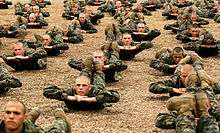
Enlisted Marines attend recruit training, known as boot camp, at either Marine Corps Recruit Depot San Diego or Marine Corps Recruit Depot Parris Island. Historically, the Mississippi River served as the dividing line which delineated who would be trained where, while more recently, a district system has ensured a more even distribution of male recruits between the two MCRD facilities. Females attend only the Parris Island depot as part of the segregated Fourth Recruit Training Battalion. All recruits must pass a fitness test to start training; those who fail receive individualized attention and training until the minimum standards are reached. Marine recruit training is the longest among the American military services; it is 13 weeks long including processing and out-processing, compared to the Army's 10 weeks, the Navy's 9 weeks,[98] the Air Forces's 8 1/2 weeks, and the Coast Guard's 8 weeks.
Following recruit training, enlisted Marines then attend The School of Infantry at Camp Geiger or Camp Pendleton. Infantry Marines begin their combat training, which varies in length, immediately with the Infantry Training Battalion (ITB). Marines in all other MOSs other than infantry train for 29 days in Marine Combat Training (MCT), learning common infantry skills, before continuing on to their MOS schools which vary in length.[99]
Uniforms
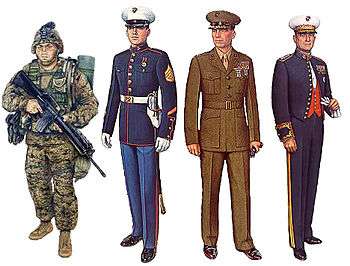
The Marine Corps has the most stable and most recognizable uniforms in the American military; the Blue Dress dates back to the early 19th century[31] and the service uniform to the early 20th century. Marines' uniforms are distinct in their simplicity; Marines do not wear unit patches or United States flags on any of their uniforms, nor name tags on their service and formal uniforms. Only a handful of skills (parachutist, air crew, explosive ordnance disposal, etc.) warrant distinguishing badges, and rank insignia is not worn on uniform headgear (with the exception of an officer's garrison service cover). While other servicemembers commonly identify with a sub-group as much as or more than their service (Ranger, submariner, aircrew, etc.), Marine uniforms do not reflect such division.
Marines have four main uniforms: Dress, Service, Utility, and Physical Training (PT). These uniforms have a few minor, but very distinct, variations from enlisted personnel to commissioned and non-commissioned officers. The Marine Corps Dress uniform is the most elaborate, worn for formal or ceremonial occasions. There are four different forms of the Dress uniform. The variations of the dress uniforms are known as "Alphas", "Bravos", "Charlies", or "Deltas". The most common being the "Blue Dress Alphas or Bravos", called "Dress Blues" or simply "Blues".It is most often seen in recruiting advertisements and is equivalent to black tie. There is a "Blue-White" Dress for summer, and Evening Dress for formal (white tie) occasions. Versions with a khaki shirt in lieu of the coat (Blue Dress Charlie/Delta) are worn as a daily working uniform by Marine recruiters and NROTC staff.[100]
The Service Uniform was once the prescribed daily work attire in garrison; however, it has been largely superseded in this role by the utility uniform. Consisting of olive green and khaki colors, it is commonly referred to as "Greens". It is roughly equivalent in function and composition to a business suit.[100]
The Utility Uniform, currently the Marine Corps Combat Utility Uniform, is a camouflage uniform intended for wear in the field or for dirty work in garrison, though it has now been standardized for regular duty. It is rendered in a distinctive MARPAT pixelated camouflage (sometimes referred to as digitals or digies) that breaks up the wearer's shape, and serves to distinguish Marine uniforms from those of other services. In garrison, the woodland and desert uniforms are worn depending on the Marine's duty station.[101] Marines consider the utilities a working uniform and do not permit their wear off-base, except in transit to and from their place of duty and in the event of an emergency. This, too, distinguishes them from other services, which have less stringent restrictions.[100]
Culture
As in any military organization, the official and unofficial traditions of the Marine Corps serve to reinforce camaraderie and set the service apart from others. The Corps' embrace of its rich culture and history is cited as a reason for its high esprit de corps.[20]

Official traditions and customs
 |
Semper Fidelis March
John Philip Sousa's "Semper Fidelis March", the official march of the U.S. Marine Corps. Performed by the U.S. Marine Band in June 1909. |
| Problems playing this file? See media help. | |
The Marines' Hymn dates back to the 19th century and is the oldest official song in the United States armed forces. The Marine motto Semper Fidelis means always faithful in Latin, often appearing as Semper Fi; also the name of the official march of the Corps, composed by John Philip Sousa. The mottos "Fortitudine" (With Fortitude); By Sea and by Land, a translation of the Royal Marines' Per Mare, Per Terram; and To the Shores of Tripoli were used until 1868.[102] The Marine Corps emblem is the Eagle, Globe, and Anchor, sometimes abbreviated "EGA", adopted in 1868.[103] The Marine Corps seal includes the emblem, also is found on the flag of the United States Marine Corps, and establishes scarlet and gold as the official colors.[104]
Two styles of swords are worn by Marines: the officers' Mameluke Sword, similar to the Persian shamshir presented to Lt. Presley O'Bannon after the Battle of Derna, and the Marine NCO sword.[31] The Marine Corps Birthday is celebrated every year on 10 November in a cake-cutting ceremony where the first slice of cake is given to the oldest Marine present, who in turn hands it off to the youngest Marine present. The celebration includes a reading of Commandant Lejeune's Birthday Message.[105] Close Order Drill is heavily emphasized early on in a Marine's initial training, incorporated into most formal events, and is used to teach discipline by instilling habits of precision and automatic response to orders, increase the confidence of junior officers and noncommissioned officers through the exercise of command and give Marines an opportunity to handle individual weapons.[106]
An important part of the Marine Corps culture is the traditional seafaring naval terminology derived from its history with the Navy.
Unofficial traditions and customs

Marines have several generic nicknames:
- Devil Dog has several oft-disputed explanations,[107][108][109] but the tradition has expanded to include the English bulldog's association with the Corps, especially as a mascot.[31]
- gyrene has dropped out of popular use.[110]
- Leatherneck refers to a leather collar formerly part of the Marine uniform during the Revolutionary War period.[111]
- Jarhead has several oft-disputed explanations.[112]
Some other unofficial traditions include mottos and exclamations:
- Oorah is common among Marines, being similar in function and purpose to the Army's hooah and the Navy's hooyah cries. Many possible etymologies have been offered for the term.[113]
- Semper Fi is a common greeting among serving and veteran Marines. It is short for the Marine Corps Motto "Semper Fidelis"
- Improvise, Adapt and Overcome has become an adopted mantra in many units.[114]
Veteran Marines
The Corps encourages the idea that "Marine" is an earned title and most Marine Corps personnel take to heart the phrase "Once a Marine, Always a Marine". They reject the term "ex-Marine" in most circumstances. There are no regulations concerning the address of persons who have left active service, so a number of customary terms have come into common use:[53]
- "Marine" is acceptable and considered complimentary by most Corps personnel.
- "Former Marine" or "Veteran Marine" is acceptable in referring to anyone who has been honorably discharged from the Corps.
- "Retired Marine" is generally reserved for those who have completed 20 or more years of service are called "Lifers" and formally retired or those who have been medically retired.
- According to one of the "Commandant's White letters" from Commandant Alfred M. Gray, Jr., referring to a Marine by their last earned rank is appropriate.[115]
Martial arts program
In 2001, the Marine Corps initiated an internally designed martial arts program, called Marine Corps Martial Arts Program (MCMAP). Due to an expectation that urban and police-type peacekeeping missions would become more common in the 21st century, placing Marines in even closer contact with unarmed civilians, MCMAP was implemented to provide Marines with a larger and more versatile set of less-than-lethal options for controlling hostile, but unarmed individuals. It is a stated aim of the program to instill and maintain the "Warrior Ethos" within Marines.[116] The Marine Corps Martial Arts program is an eclectic mix of different styles of martial arts melded together. MCMAP consists of punches and kicks from Taekwondo and Karate, opponent weight transfer from Jujitsu, ground grappling involving joint locking techniques and chokes from Brazilian jiu-jitsu, and a mix of knife and baton/stick fighting derived from Eskrima, and elbow strikes and kick boxing from Muay Thai. Marines begin MCMAP training in boot camp, where they will earn the first of five available belts.[117]
Equipment
As of 2013, the typical infantry rifleman carries $14,000 worth of gear (excluding night-vision goggles), compared to $2,500 a decade earlier. The number of pieces of equipment (everything from radios to trucks) in a typical infantry battalion has also increased, from 3,400 pieces of gear in 2001 to 8,500 in 2013.[118]
Infantry weapons
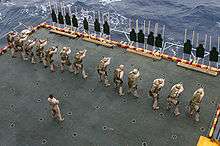
The basic infantry weapon of the Marine Corps is the M16 assault rifle family, with a majority of Marines being equipped with the M16A2 or M16A4 service rifles (the M16A2 is being phased out). The M4 carbine[119] and Colt 9mm SMG[120] have also been issued. The standard side arm is the M9A1 pistol. The Colt M1911A1 is also being put back into service as the M45A1 Close Quarter Battle Pistol (CQBP) in small numbers. Suppressive fire is provided by the M249 SAW (currently transitioning to the M27 IAR) and M240 machine guns, at the squad and company levels respectively. In addition, indirect fire is provided by the M203 grenade launcher and the M32 grenade launcher in fireteams, M224 60 mm mortar in companies, and M252 81 mm mortar in battalions. The M2 .50 caliber heavy machine gun and MK19 automatic grenade launcher (40 mm) are available for use by dismounted infantry, though they are more commonly vehicle-mounted.
Precision firepower is provided by the M40 series, and the Barrett M107, while designated marksmen use the DMR (being replaced by the M39 EMR), and the SAM-R.[121]
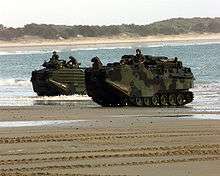
The Marine Corps utilizes a variety of direct-fire rockets and missiles to provide infantry with an offensive and defensive anti-armor capability. The SMAW and AT4 are unguided rockets that can destroy armor and fixed defenses (e.g., bunkers) at ranges up to 500 meters. The smaller and lighter M72 LAW can destroy targets at ranges up to 200 meters.[122][123] The Predator SRAW, FGM-148 Javelin and BGM-71 TOW are anti-tank guided missiles. The Javelin can utilize top-attack profiles to avoid heavy frontal armor. The Predator is a short-range fire-and-forget weapon; the Javelin and TOW are heavier missiles effective past 2,000 meters that give infantry an offensive capability against armor.[124]
The USMC is currently seeking to purchase commercial off-the-shelf bullet-trap or shoot-through rifle-grenades.[125] These grenades will provide individual Marines additional firepower and will allow indirect fire against targets in defilade, behind walls and buildings or rooftops and elevated positions at ranges between 30 and 150 meters.[125]
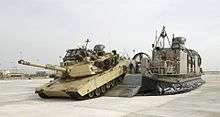
Ground vehicles
The Corps operates the same HMMWV and M1A1 Abrams tank as does the Army. However, for its specific needs, the Corps uses a number of unique vehicles. The LAV-25 is a dedicated wheeled armored personnel carrier, similar to the Army's Stryker vehicle, used to provide strategic mobility.[126] Amphibious capability is provided by the AAV-7A1 Assault Amphibious Vehicle, an armored tracked vehicle that doubles as an armored personnel carrier, due to be replaced by the Amphibious Combat Vehicle, a faster vehicle with superior armor and weaponry. The threat of land mines and improvised explosive devices in Iraq and Afghanistan has seen the Corps begin purchasing heavy armored vehicles that can better withstand the effects of these weapons as part of the Mine Resistant Ambush Protected vehicle program.[127] The Marine Corps has ordered 1,960 MRAP vehicles, hoping to use them to replace HMMWVs and some Medium Tactical Vehicle Replacements on patrols in Iraq.[128] The Logistics Vehicle System Replacement began replacing the Logistics Vehicle System in 2009.[129]
Prior to 2005, the Marines operated exclusively tube artillery – the M198 155 mm howitzer, now being replaced by the M777 155 mm howitzer. However, the Corps has expanded its artillery composition to include the High Mobility Artillery Rocket System (HIMARS), a truck-mounted rocket artillery system. Both are capable of firing guided munitions.[130]
Aircraft
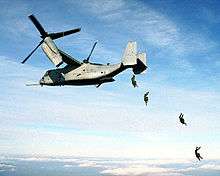
The organic aviation capability of the Marine Corps is essential to its mission. The Corps operates both rotary-wing and fixed-wing aircraft mainly to provide assault support and close air support to its ground forces. However, other aircraft types are also used in a variety of support and special-purpose roles.
The light transport and attack capabilities are provided by the Bell UH-1Y Venom and Bell AH-1 SuperCobra, which is being replaced by the Bell AH-1Z Viper.[131] Medium-lift squadrons flying the CH-46E Sea Knight and CH-53D Sea Stallion helicopters are converting to the MV-22 Osprey tiltrotor with superior range and speed. Heavy-lift squadrons are equipped with the CH-53E Super Stallion helicopter, eventually to be replaced with the upgraded CH-53K.[132]

Marine attack squadrons fly the AV-8B Harrier II; while the fighter/attack mission is handled by the single-seat and dual-seat versions of the F/A-18 Hornet strike-fighter aircraft. The AV-8B is a V/STOL aircraft that can operate from amphibious assault ships, land air bases and short, expeditionary airfields, while the F/A-18 can only be flown from land or aircraft carriers. Both are slated to be replaced by 340 of the STOVL B version of the F-35 Lightning II, beginning training operations in 2008,[133] and 80 of the carrier F-35C versions for deployment with Navy carrier air wings.[134][135][136][137]
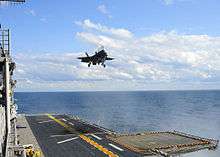
In addition, the Corps operates its own organic aerial refueling and electronic warfare (EW) assets in the form of the KC-130 Hercules and EA-6B Prowler, respectively. The Hercules doubles as a ground refueler and tactical-airlift transport aircraft. The Prowler is one of the only two active tactical electronic warfare aircraft left in the United States inventory, and has been labeled a "national asset"; it is used along with the Navy's EA-18G Growlers to assist in any American combat action since the retirement of the Air Force's EW aircraft.[138] The Marine Corps plans to retire the Prowlers by September 2016 and after that time EW capability will come from Marine Air-Ground Task Force Electronic Warfare, which is a strategy where every platform contributes and functions as a sensor, shooter and sharer.[139]
The Marines operate unmanned aerial vehicles: the RQ-7 Shadow and Scan Eagle for tactical reconnaissance.[140][141]
Marine Fighter Training Squadron 401 (VMFT-401), operates F-5E, F-5F and F-5N Tiger II aircraft in support of air combat adversary (aggressor) training. Marine Helicopter Squadron One (HMX-1) operates the VH-3D Sea King and VH-60N Whitehawk helicopters in the VIP transport role, most notably Marine One, but are due to be replaced. A single Marine Corps C-130 Hercules aircraft, "Fat Albert", is used to support the U.S. Navy's flight demonstration team, the "Blue Angels".
In April 2016 it was reported that the vast majority of USMC aircraft were not capable of flight due to the toll of long wars in Afghanistan and Iraq, the fight against ISIS and budget cuts precluding the purchase of the parts needed to fix an aging fleet. Official statistics confirm that, of 276 F/A-18 Hornet strike fighters in the Marine Corps inventory, only about 30% are ready to fly; and only 42 of 147 heavy-lift CH-53E Super Stallion helicopters are airworthy. Average monthly flight time per pilot has dropped from an average of between 25 and 30 hours in 2006 to just over 4 hours in 2016.[142]
Relationship with other services
In general, the Marine Corps shares many resources with the other branches of the United States military. However, the Corps has consistently sought to maintain its own identity with regard to mission, funding, and assets, while utilizing support available from the larger branches. While the Marine Corps has far fewer installations both in the U.S. and worldwide than the other branches, many Army posts, Naval stations, and Air Force bases have a Marine presence. They also cross train with other countries.
United States Navy
_welldeck.jpg)
The Marine Corps' counterpart under the Department of the Navy is the United States Navy. As a result, the Navy and Marine Corps have a close relationship, more so than with other branches of the military. Whitepapers and promotional literature have commonly used the phrase "Navy-Marine Corps Team",[143][144] or refer to "the Naval Service". Both the Chief of Naval Operations (CNO) and Commandant of the Marine Corps report directly to the Secretary of the Navy.
Cooperation between the two services really begins with the training and instruction of Marines. The Corps receives a significant portion of its officers from the United States Naval Academy and Naval Reserve Officers Training Corps (NROTC). NROTC staff includes Marine instructors, while Marine drill instructors contribute to training of officers in the Navy's Officer Candidate School. Marine aviators and flight officers are trained in the Naval Aviation training pipeline and are winged as Naval Aviators or Naval Flight Officers.
Training alongside each other is viewed as critical, as the Navy provides transport, logistical, and combat support to put Marine units into the fight, such as maritime prepositioning ships and naval gunfire support. Most Marine aviation assets ultimately derive from the Navy, with regard to acquisition, funding, and testing, and Navy aircraft carriers typically deploy with a Marine squadron alongside Navy squadrons. Marines do not recruit or train noncombatants such as chaplains or medical/dental personnel; naval personnel fill these roles. Some of these sailors, particularly Hospital Corpsmen and Religious Programs Specialists, generally wear Marine uniforms emblazoned with Navy insignia. Conversely, the Marine Corps is responsible for conducting land operations to support naval campaigns, including the seizure of naval and air bases. Both services operate a network security team in conjunction.
Marines and Sailors share many naval traditions, especially terminology and customs. Marine Corps Medal of Honor recipients wear the Navy variant of this and other awards;[25] and with few exceptions, the awards and badges of the Navy and Marine Corps are identical. Much of testing for new Marine Corps aircraft is done at NAS Patuxent River. The Navy's Blue Angels flight demonstration team is staffed by both Navy and Marine officers and enlisted men, and includes a Marine C-130 Hercules aircraft.[25]
In 2007, the Marine Corps joined with the Navy and Coast Guard to adopt a new maritime strategy called A Cooperative Strategy for 21st Century Seapower that raises the notion of prevention of war to the same philosophical level as the conduct of war.[145] This new strategy charts a course for the Navy, Coast Guard and Marine Corps to work collectively with each other and international partners to prevent regional crises, man-made or natural, from occurring or reacting quickly should one occur to avoid negative impacts to the United States.
The Marines have reduced the requirement for large amphibious ships from 42 to a bare minimum of 33 ships; the fleet currently stands at 29 ships and is likely to shrink in the future.[146]
United States Army
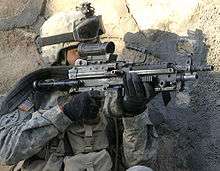
The Marine Corps combat capabilities in some ways overlap those of the United States Army, the latter having historically viewed the Corps as encroaching on the Army's capabilities and competing for funding, missions, and renown. The attitude dates back to the founding of the Continental Marines, when General George Washington refused to allow the initial Marine battalions to be drawn from among his Continental Army. Most significantly, in the aftermath of World War II, Army efforts to restructure the American defense establishment included the dissolution of the Corps and the folding of its capabilities into the other services. Leading this movement were such prominent Army officers as General Dwight D. Eisenhower and Army Chief of Staff George C. Marshall.[53] With most of the 2000s spent in operations in Afghanistan and Iraq, Secretary of Defense Robert Gates has voiced concerns that the Marines are becoming a "second Army".[29]
Doctrinally, the Marine Corps' focus is on being expeditionary and independent, and places emphasis on amphibious mobility and combined arms; these make it a much lighter force than many units of the Army. A larger percentage of the Marine Corps' personnel and assets are in the combat arms (infantry, artillery, armor, and close air support) than the Army. However, the Army maintains much larger and diverse combat arms (infantry, armor, artillery, special operations), ground transport, and logistics, while the Marines have a more diverse aviation arm (which constitutes a larger percentage of forces), and is usually organic to the MAGTF. Marines operate as expeditionary units and are completely amphibious. The Marine Corps focus is on standardized infantry units with the other arms in support roles, as the "Every Marine a rifleman" creed shows. This commitment to standardized units can be seen in the short-lived experiment of the Marine Raiders, born in World War II, which was controversial, while the U.S. Army's 75th Ranger Regiment, also born in World War II, enjoys high prestige to this day. The Army has a longer continuous tradition of special operations forces; the Marines joined the Special Operations Command with the establishment of MCSOCOM Detachment One in 2003.[89]
The Marines often leverage the Army's acquisition of ground equipment (as well as benefiting from Army research and development resources), training resources, and other support concepts. The majority of vehicles and weapons are shared with, modified, or inherited from Army programs.
Culturally, Marines and soldiers share most of the common U.S. military slang and terminology, but the Corps utilizes a large number of naval terms and traditions incompatible with the Army lifestyle, as well as their own unique vernacular. Many Marines regard their culture to have a deep warrior tradition, with the ethos that "Every Marine a rifleman" and emphasis on cross-training and combat readiness despite actual job, be it infantry or otherwise. One source states Marines tend to decentralize and push leadership to lower levels, while fostering initiative to a greater degree.[147]
United States Air Force

While the majority of Marine aviation assets ultimately derive from the Navy, some support is drawn from the United States Air Force. The Marine Corps makes extensive use of the USAF Air Mobility Command to airlift Marines and equipment.
The Air Force traditionally provides the Joint Force Air Component Commander who controls "sorties for air defense, and long range interdiction and reconnaissance" while the MAGTF commander retains control of the Marines' organic aviation assets.[148][149]
Budget
The Marine Corps accounts for around six percent of the military budget of the United States. The cost per Marine is $20,000 less than the cost of a serviceman from the other services, and the entire force can be used for both hybrid and major combat operations,[150] enabling it to carry out full-scale military action, peacekeeping operations and humanitarian aid – the entire Three Block War. Note that these per capita costs do not account for support provided by the Navy and other branches, such as the Navy's amphibious warfare ships and long-range air transport by the USAF.[151] However given expected defense budget cuts, the Marines are well positioned for "fielding cheap options for an uncertain world."[152] The Marine Corps budget is comparably well handled with a tiny fraction of the Anti-Deficiency Act violations of any of the other three major branches.[153] In 2013, the USMC became the first American military branch to ever have a fully audited annual budget.[154]
See also
Notes and references
- ↑ "Marine Corps Decade Timeline | Marine Corps history". Marines.com. Retrieved 15 July 2014.
- 1 2 3 "Department of Defense (DoD) Releases Fiscal Year 2017 President's Budget Proposal". U.S. Department of Defense. 9 February 2016. Retrieved 11 February 2016.
- ↑ Flightglobal – World Air Forces 2015 (PDF), Flightglobal.com
- ↑ Lejeune, Major General John A (18 April 1925). "Marine Corps Order No. 4 (Series 1925)". Commandant of the Marine Corps. United States Marine Corps History Division. Archived from the original on 5 October 2010. Retrieved 2 February 2010.
- ↑ Loredo-Agostini, Sgt Heidi E. (30 July 2009). "Ready for the Corps: Marines recruit latest mascot from South Texas". Recruiting Station San Antonio. Castroville, Texas: United States Marine Corps. Retrieved 22 December 2010.
- ↑ Dobbs, LCpl Chris (25 July 2008). "Marine Barracks' mascot, Chesty the XII, retires after more than 40 'dog years' of faithful service". Marine Barracks, Washington, D.C.: United States Marine Corps. Retrieved 22 December 2010.
- 1 2 3 Gen. Charles C. Krulak (1996). "Operational Maneuver from the Sea" (PDF). Headquarters Marine Corps.
- ↑ Hoffman, Colonel Jon T., USMC: A Complete History, Marine Corps Association, Quantico, VA, (2002), p. 57.
- ↑ John Pike. "Tactical Aviation Integration". globalsecurity.org. Retrieved 1 April 2015.
- ↑ "U.S. Marine Corps Decade Timeline".
- ↑ "Breaking Defense – The future of the Marines".
- 1 2 3 4 5 Warren, James A. (2005). American Spartans: The U.S. Marines: A Combat History From Iwo Jima to Iraq. New York: Free Press, Simon & Schuster. ISBN 0-684-87284-6.
- ↑ Hough, Col Frank O. (USMCR); Ludwig, Maj Verle E. (USMC), and Henry I. Shaw, Jr. "Part I, Chapter 2: Evolution of Modern Amphibious Warfare, 1920–1941". Pearl Harbor to Guadalcanal. History of U.S. Marine Corps Operations in World War II, Volume I. Historical Branch, HQMC, United States Marine Corps. Retrieved 2 June 2007.
- ↑ Garand, George W. & Truman R. Strobridge (1971). "Part II, Chapter 1: The Development of FMFPac". Western Pacific Operations. History of U.S. Marine Corps Operation in World War II, Volume IV. Historical Branch, HQMC, United States Marine Corps. Retrieved 3 August 2008.
- ↑ Frank, Benis M & Henry I. Saw, Jr. (1968). "Part VI, Chapter 1: Amphibious Doctrine in World War II". Victory and Occupation. History of U.S. Marine Corps Operations in World War II, Volume V. Historical Branch, HQMC, United States Marine Corps. Retrieved 3 August 2008.
- ↑ John Howard Dalton, Secretary of the Navy; Jeremy Michael Boorda, Chief of Naval Operations; Carl E. Mundy, Commandant of the Marine Corps (9 November 1994). "Forward... From the Sea". United States Department of the Navy.
- ↑ The United States Coast Guard is smaller, about one-fifth the size of the U.S. Marine Corps, but it is part of United States Department of Homeland Security and does not normally operate under the DoD except during times of war and as directed by the U.S. president. The USMC is the largest marine corps force in the world and is larger than the armed forces of many significant powers; for example, the USMC is larger than the active duty Israel Defense Forces.
- ↑ "Israeli Defense Forces, CSIS" (PDF). 25 July 2006. p. 12.
- ↑ "United States Armed Force Strength Figures" (PDF). DOD. 31 January 2013.
- 1 2 3 4 Estes, Kenneth W. (2000). The Marine Officer's Guide, 6th Edition. Naval Institute Press. ISBN 1-55750-567-5.
- ↑ Clinton, William J. (2000). "Remarks Celebrating the 200th Anniversary of the United States Marine Corps Band 10 July 1998". In Office of the Federal Register. Public Papers of the Presidents of the United States, William J. Clinton, 1998, Book 2: July 1 to December 31, 1998. Government Printing Office. p. 1217. ISBN 978-1-4034-4551-3.
The Marine Band played at Thomas Jefferson's Inauguration in 1801 and hasn't missed a single one since. Jefferson was a violin player who loved music almost as much as he loved freedom. He named the band "The President's Own".
- ↑ Hearn, Chester G. (2007). Marines: An Illustrated History: the United States Marine Corps from 1775 to the 21st Century. Zenith Imprint. p. 180. ISBN 978-0-7603-3211-5.
- ↑ Keller, Scott (2004). Marine Pride: A Salute to America's Elite Fighting Force. Citadel Press. p. 56. ISBN 978-0-8065-2603-4.
- ↑ "The Role of Marines in Embassy Security".
- 1 2 3 4 Lawliss, Chuck (1988). The Marine Book: A Portrait of America's Military Elite. New York: Thames and Hudson.
- ↑ Milks, Keith A. (8 May 2003). Ensuring 'Every Marine a Rifleman' is more than just a catch phrase. Marine Corps News. 22 MEU, USMC. Story ID # 20071230234422. Archived from the original on 24 December 2007.
- ↑ Lieutenant Colonel R.D. Heinl, Jr., USMC (1947). "Marines in WWII Historical Monograph: The Defense of Wake". Historical Section, Division of Public Information, Headquarters, USMC.
- ↑ Lind, William S.; Wyly, Michael, Col. (1985). Maneuver Warfare Handbook. Boulder, Colorado: Westview Press. ISBN 0-86531-862-X.
- 1 2 Kevin Baron (12 August 2010). "Gates: Time has come to re-examine future of Marine Corps".
- ↑ Patrick, Capt Timothy (10 December 2010). "Marines return to their amphibious roots". II Marine Expeditionary Force. United States Marine Corps. Retrieved 22 December 2010.
- 1 2 3 4 5 6 7 Chenoweth, H. Avery, Colonel, USMCR (Ret.); Nihart, Brooke, Colonel , USMC (Ret.) (2005). Semper fi: The Definitive Illustrated History of the U.S. Marines. New York: Main Street. ISBN 1-4027-3099-3.
- ↑ "Marine Corps Expeditionary Energy Office.". Marines.mil.
- ↑ U.S. Congress (11 July 1798). "An Act for Establishing and Organizing a Marine Corps".
- ↑ Captain John Barry (9 February 1798). "Muster Roll of Officers, Petty Officers, Seamen, and Marines, on the Frigate United States". Retrieved 16 May 2009.
- ↑ U.S. Congress (18 March 1794). "Act to provide a Naval Armament". NARA. Retrieved 16 May 2009.
- ↑ Richard Leiby, Terrorists by Another Name: The Barbary Pirates, The Washington Post, 15 October 2001
- 1 2 3 4 5 Simmons, Edwin H. (2003). The United States Marines: A History, Fourth Edition. Annapolis, Maryland: Naval Institute Press. ISBN 1-59114-790-5.
- ↑ U.S. Congress (30 June 1834). "An Act for the Better Organization of the United States Marine Corps". Retrieved 3 August 2008.
- ↑ Moskin, J. Robert (1987). The U.S. Marine Corps Story. New York: McGraw-Hill.
- ↑ Elliott, Daniel T. (2008). "Archaeological Reconnaissance at the Drudi Tract, Tybee Island, Chatham County, Georgia" (PDF). Savannah, Georgia: LAMAR Institute Publication Series. p. 9. Retrieved 7 October 2011.
- ↑ Reference Branch (2016). "Marine Corps Casualties: 1775-2015". Frequently Requested. USMC History Division. Retrieved 23 April 2016.
- ↑ Ellsworth, Harry Allanson (1934). One Hundred Eighty Landings of United States Marines 1800–1934. Washington, D.C.: History and Museums Division, HQ, USMC.
- ↑ "Report on Marine Corps Duplication of Effort between Army and Navy". U.S. Marine Corps. 17 December 1932.Contains a very detailed account of almost all the actions of the Continental Marines and USMC until 1932. It is available in scanned TIFF format from the archives of the Marine Corps University.
- ↑ Mitchell, John Ames (1918). "Teufel-Hunden". Life Magazine. 72: 759. Retrieved 7 October 2011.
- ↑ "History of Marine Corps Aviation – World War One". AcePilots.com. Archived from the original on 11 January 2006.
- ↑ Chad L. Williams, Torchbearers of Democracy: African American Soldiers in the World War I Era. Chapel Hill, North Carolina: University of North Carolina Press, 2010; pg. 6.
- ↑ Hewitt, Linda J. (1974). Women Marines In World War I (1974). United States Marine Corps History and Museums Division. Retrieved 2014-12-31.
- ↑ "Women Marines". Usmcpress.com. Retrieved 2015-08-11.
- ↑ Ballendorf, Dirk Anthony (1997). Pete Ellis: an amphibious warfare prophet, 1880–1923. Annapolis, Maryland: Naval Institute Press.
- ↑ Derrick Wright and Jim Laurier, Iwo Jima 1945: The Marines raise the flag on Mount Suribachi (2012)
- ↑ "Marines in World War II Commemorative Series". Marine Corps Historical Center. Archived from the original on 8 February 2008. Retrieved 17 January 2008.
- ↑ Owens, Ron (2004). Medal of honor: historical facts & figures. Turner Publishing Company. p. 110. ISBN 978-1-56311-995-8.
- 1 2 3 Krulak, Victor H. (1984). First To Fight: An Inside View of the U.S. Marine Corps. Annapolis, Maryland: Naval Institute Press. ISBN 0-87021-785-2. Chapter 7, The Marines' Push Button 113–119
- ↑ Fehrenbach, T. R. (1994). This Kind of War: The Classic Korean War History. Brassey's. ISBN 1-57488-259-7.
- ↑ "Fast Facts on the Korean War". History Division, U.S. Marine Corps. Archived from the original on 6 August 2007.
- ↑ Millet, Alan R. (1991). Semper Fidelis: The History of the United States Marine Corps. New York: Simon & Schuster. p. 605. ISBN 978-0-02-921596-8.
- ↑ Casualties: U.S. Navy and Marine Corps, history.navy.mil.
- ↑ Official Navy figures number the Marine deaths at 13,091. This source provides a number of 14,837. "U.S. Military Casualties in Southeast Asia". The Wall-USA. 31 March 1997.
- ↑ "Casualties: U.S. Navy and Marine Corps Personnel Killed and Wounded in Wars, Conflicts, Terrorist Acts, and Other Hostile Incidents". Naval Historical Center, Department of the Navy. 7 August 2006.
- ↑ "Marines Awarded the Medal of Honor". United States Marine Corps. Archived from the original on 6 August 2007.
- ↑ Simmons, 247. Roughly 800,000 Marines served in Vietnam, as opposed to 600,000 in World War II.
- ↑ "The preannounced landing of U.S. Marines was witnessed by millions of U.S. primetime television viewers" (PDF). United States Naval Aviation, 1910–1995. U.S. Navy. (PDF file, see "1992, 9 December" on p. 16)
- ↑ "Address to Congress". Whitehouse. Retrieved 3 August 2008.
- ↑ "Gates Announces Major Pentagon Priority Shifts". CNN. 9 April 2009. Retrieved 14 April 2009.
- ↑ Shanker, Thom (8 May 2010). "Gates Takes Aim at Pentagon Spending". The New York Times. Retrieved 9 May 2010.
- ↑ Jaffe, Greg (9 May 2010). "Gates: Cuts in Pentagon bureaucracy needed to help maintain military force". Washington Post. Retrieved 9 May 2010.
- ↑ Smith, Rich (13 November 2010). "Marines Under Fire From Pentagon Cuts". Money Times. Retrieved 14 November 2010.
- ↑ "Amos: America Needs a Robust Crisis Response Force". Defense One. Retrieved 1 April 2015.
- ↑ "Gen. Amos: 174,000 force would mean 11 fewer battalions, 14 fewer squadrons". Military Times. Retrieved 1 April 2015.
- ↑ "War Against Terror Will Involve Amorphous Front Lines". CNN Transcript. CNN. 1 October 2001. Retrieved 27 April 2007.
- ↑ "Marines land in Afghanistan". International Herald Tribune. Archived from the original on 22 May 2008. Retrieved 3 August 2008.
- ↑ "Marines launch attack on Taliban in Helmand". The Telegraph. 29 April 2008. Retrieved 13 December 2010.
- ↑ "7,000 Marines Join Fight In Afghanistan". Camp Leatherhead (sic): CBS News. Associated Press. 8 June 2009. Retrieved 3 November 2009.
- ↑ Gal Perl Finkel, Back to the ground?, Israel Hayom, November 8, 2015.
- ↑ West, Bing; General Ray L. Smith (September 2003). The March Up: Taking Baghdad with the 1st Marine Division. New York: Bantam Books. p. 17. ISBN 0-553-80376-X.
- ↑ West, Bing (October 2005). No True Glory: A Frontline Account of the Battle for Fallujah. New York: Bantam Dell. pp. 111–113. ISBN 978-0-553-80402-7.
- ↑ "Marines face charges in Haditha killings". CNN. Archived from the original on 24 January 2007. Retrieved 27 April 2007.
- ↑ White, Josh; Geis, Sonya (22 June 2006). "8 Troops Charged In Death Of Iraqi". CNN. Retrieved 3 August 2008.
- 1 2 "Marines end role in Iraq as Biden visits Baghdad". The Detroit News. Retrieved 23 January 2010.
- ↑ Burns, Robert (25 January 2010). "Are Marines Out of Iraq for Good?". Military.com. Associated Press. Retrieved 28 January 2010.
- ↑ "U.S. to Send 275 Marines to Iraq, Won't Rule Out Cooperation With Iran – KTLA". KTLA. Retrieved 1 April 2015.
- ↑ "Fact Sheet – CJTF-HOA". Combined Joint Task Force – Horn of Africa. Archived from the original on 3 January 2008. Retrieved 3 August 2008.
- ↑ "USMC.mil – 26th MEU in HOA". United States Marine Corps. Archived from the original on 10 December 2007. Retrieved 3 August 2008.
- ↑ United States Marine Corps (2007). Marine Corps Operations. Cosimo, Inc. p. 19. ISBN 978-1-60206-062-3.
- ↑ Williams, BGen Willie J. (October 2004). "Bases and Stations Are They Relevant?". Marine Corps Gazette. Marine Corps Association. 88 (10): 12–16.
- ↑ "About MCB Quantico".
- ↑ "About Marine Corps University". U.S. Marine Corps. Archived from the original on 27 September 2007. Retrieved 27 September 2007.
- ↑ Smith, Jr., W Thomas (2005). "Marines, Navy SEALs Forge New Special Operations Team; An exclusive interview with U.S. Navy SEAL Commander Mark Divine". Military.com. Retrieved 3 August 2008.
- 1 2 Priddy, Maj. Wade (2006). "Marine Detachment 1: Opening the door for a Marine force contribution to USSOCom". Marine Corps Gazette. Marine Corps Association. 90 (6): 58–59.
- ↑ Graham, Bradley (2 November 2005). "Elite Marine Unit to Help Fight Terrorism, Force to Be Part of Special Operations". Washington Post. Retrieved 3 August 2008.
- ↑ Estes (1986), p. 60
- ↑ "Marines.mil - Leaders". marines.mil.
- ↑ "Dunford Replaces Amos as New Marine Corps Commandant". Military.com. Retrieved 1 April 2015.
- ↑ "Leaders". Marines.mil. Retrieved 3 February 2013.
- ↑ "DoD Defense Insignia".
- ↑ "Marine Corps to remove word "man" from 19 key job titles". MSN. Retrieved 30 June 2016.
- ↑ Clancy, Tom (1996). Marine: a guided tour of a Marine expeditionary unit. Penguin. p. 46. ISBN 978-0-425-15454-0.
- ↑ Bernard L. DeKoning, ed. (2006). Recruit Medicine: Textbooks of Military Medicine. Government Printing Office. p. 33. ISBN 978-0-16-076718-0.
- ↑ Ricks, Thomas E. (2007). Making the Corps: 10th Anniversary Edition with a New Afterword by the Author (10 ed.). Simon and Schuster. p. 239. ISBN 978-1-4165-4450-0.
- 1 2 3 "Mco p1020.34g". United States Marine Corps. Retrieved 27 November 2005.
- ↑ ALMAR 007/08 directing seasonal uniform changes
- ↑ "USMC Customs and Traditions". History Division, U.S. Marine Corps. Archived from the original on 4 March 2007.
- ↑ "U.S. Marine Corps Emblem". U.S. Marine Corps.
- ↑ "Marine Corps Emblem and Seal". Customs and Traditions. Reference Branch, History Division, United States Marine Corps. Retrieved 11 October 2008.
- ↑ "Marine Corps Birthday Celebration". USMC History Division. Archived from the original on 6 August 2007.
- ↑ "Drill a Platoon Sized Unit". Student Handout. Marine Corps University. Archived from the original on 10 July 2007.
- ↑ "Marine Corps History, Customs, and Courtesies". U.S. Marine Guidebook. United states Marine Corps. 2010. p. 37. ISBN 978-1-60239-941-9.
Marines fought like teufel hunden, legendary wild, devil dogs that at one time roamed the forests of northern Germany
- ↑ Myers, Thomas (1988). "Hearts of Darkness". Walking Point: American Narratives of Vietnam. Oxford University Press, USA. p. 114. ISBN 978-0-19-505351-7.
He reminds his charges that "at Belleau Wood the Marines were so vicious that the German infantrymen called them Teufel-Hunden – 'devil dogs'
- ↑ Waseleski, Michael (2009). To Lead by the Unknowing, to Do the Unthinkable. AuthorHouse. p. 5. ISBN 978-1-4389-5676-3.
the 5th and 6th Marine Regiments earned the nickname of "Teufel Hunden" (devil dog) by the Germans in World War I during the 1918 Château-Thierry campaign near the French village of Bouresches, the Battle of Belleau Wood
- ↑ Rottman, Gordon (2011). "GI and Gyrene Jargon US Army and Marine Corps Slang". FUBAR F***ed Up Beyond All Recognition: Soldier Slang of World War II. Osprey Publishing. p. 49. ISBN 978-1-84908-653-0.
based on Chinese pronunciation of Marine
- ↑ "Marine Corps History, Customs, and Courtesies". U.S. Marine Guidebook. United states Marine Corps. 2010. p. 37. ISBN 978-1-60239-941-9.
In 1804 the Secretary of the Navy ordered Marines to wear black leather stock collars when on duty
- ↑ Rottman, Gordon (2011). "GI and Gyrene Jargon US Army and Marine Corps Slang". FUBAR F***ed Up Beyond All Recognition: Soldier Slang of World War II. Osprey Publishing. p. 51. ISBN 978-1-84908-653-0.
Most likely it was the pillbox cap and high stiff collar making a Marine appear similar to a Mason jar
- ↑ Hiresman III, LCpl. Paul W. "The meaning of 'Oorah' traced back to its roots". Marine Corps News. United States Marine Corps. Archived from the original on 24 December 2007.
- ↑ Santamaria, Jason A.; Vincent Martino; Eric K. Clemons (2005). The Marine Corps Way: Using Maneuver Warfare to Lead a Winning Organization. McGraw-Hill Professional. p. 149. ISBN 978-0-07-145883-2.
Long before Hollywood popularized it, Marines used the phrase to reflect their preference for being a fluid, loosely reined force that could spontaneously react to rapidly changing situations, rather than a rigid outfit that moved in a specific direction with a precise plan.
- ↑ Freedman, David H. (2000). Corps Business: The 30 Management Principles of the U.S. Marines. New York: Collins.
- ↑ Yi, Capt. Jamison, USMC. "MCMAP and the Warrior Ethos", Military Review, November–December 2004.
- ↑ Franck, Loren (2003). "The Few and the Proud: A Tradition of Excellence Fuels the US Marine Corps Martial Arts Program". Black Belt. 41 (7): 70.
- ↑ Corps to Industry: Prepare for the Worst – DoDBuzz.com, 26 September 2013
- ↑ "Top Marine Glad to Have M16A4 Standard". Kit Up!. Military.com. 25 March 2010. Retrieved 27 April 2010.
- ↑ "NAVMC DIRECTIVE 3500.90: MARINE CORPS SECURITY GUARD BATTALION TRAINING AND READINESS MANUAL, (SHORT TITLE: MSGBN T&R MANUAL)" (PDF). Headquarters Marine Corps. 4 April 2006. Archived from the original (PDF) on 10 January 2009. Retrieved 11 June 2014.
- ↑ "M40A1 Sniper Rifle". USMC Fact File. U.S. Marine corps. Archived from the original on 25 February 2007.
- ↑ John Antal "Packing a Punch: America's Man-Portable Antitank Weapons" page 88 Military Technology 3/2010 ISSN 0722-3226
- ↑ "Light Assault Weapon (LAW)". FBO.gov.
- ↑ "Tube Launched, Optically Tracked, Wire Guided (TOW) Missile Weapon System". USMC Fact File. U.S. Marine Corps. Archived from the original on 11 February 2007.
- 1 2 13-Ammunition and Explosives – M6785412I1003 (Archived) – Federal Business Opportunities: Opportunities. Fbo.gov (9 November 2011).
- ↑ "Light Armored Vehicle-25 (LAV-25)". USMC Fact File. U.S. Marine Corps. Archived from the original on 28 April 2003.
- ↑ "U.S. Marine Corps Orders More Force Protection Vehicles". Force Protection, Inc. – In the News. Force Protection, Inc. August 2006. Retrieved 3 January 2007.
- ↑ Andrew Feickert (21 August 2007). "Mine-Resistant, Ambush-Protected (MRAP) Vehicles: Background and Issues for Congress" (PDF). United States Congress.
- ↑ Lamothe, Dan (22 October 2009). "First LVSR truck arrives in Afghanistan". Marine Corps Times. Gannett Company. Retrieved 23 October 2009.
- ↑ Lewis, Maj. J Christopher (July 2006). "The Future Artillery Force...Today". Marine Corps Gazette. Marine Corps Association (July 2006): 24–25.
- ↑ "AH-1W Super Cobra Helicopter". USMC Fact File. U.S. Marine Corps. Archived from the original on 5 February 2007. Retrieved 3 August 2008.
- ↑ "Marine Corps Rotary Wing". Federation of American Scientists.
- ↑ "F-35 Joint Strike Fighter Program". Department of Defense. Retrieved 3 August 2008.
- ↑ Daniel, Lisa (14 March 2011). "Plan Improves Navy, Marine Corps Air Capabilities". American Forces Press Service. United States Department of Defense. Retrieved 23 March 2011.
- ↑ Cavas, Christopher P. (14 March 2011). "More Marines to fly carrier-variant JSFs". Marine Corps Times. Retrieved 23 March 2011.
- ↑ Cifuentes, Michael S. (14 March 2011). "Marine Corps continues flying with Joint Strike Fighter program". Headquarters Marine Corps. Retrieved 11 June 2014.
- ↑ "U.S. Marine Corps Received Its First F-35C Lightning II Carrier Variant". 29 January 2015.
- ↑ "EA-6B Prowler". USMC Fact File. U.S. Marine corps. Archived from the original on 23 October 2006. Retrieved 3 August 2008.
- ↑ Prowler "Final Four" perform division flight Marine Corps, 2 March 2016
- ↑ Talton, Trista. "U.S. Marines' Shadow UAV Sees First Combat". Defensenews.com. Retrieved 3 August 2008.
- ↑ Scully, Megan. "Army assumes Navy, Marine UAV training". Seapower. Retrieved 6 December 2007.
- ↑ "Budget Cuts Leaving Marine Corps Aircraft Grounded". Military.com. 15 April 2016.
- ↑ Clark, Adm. Vern; Hinton, Don (October 2002). "Sea Power 21". Proceedings. Naval Institute Press. 130 (October 2002): 3005. doi:10.1090/S0002-9939-02-06392-X. Archived from the original on 27 September 2007. Retrieved 28 July 2006.
- ↑ Lt. Col. James Kuhn (2 November 2005). Enduring Freedom (Film). Department of the Navy.
- ↑ Jim Garamone (17 October 2007). "Sea Services Unveil New Maritime Strategy". Navy News Service. Retrieved 3 August 2008.
- ↑ Erwin, Sandra. "Marines Worry About Future Shortage of Navy Ships." National Defense Magazine, 19 April 2011.
- ↑ Connable, Maj Ben (2008). "Culture Warriors: Marine Corps Organizational Culture and Adaptation to Cultural Terrain" (PDF). Small Wars Journal. Small Wars Foundation.
- ↑ Purpose of JFACC (archived) at the Wayback Machine (archived 19 November 2005). U.S. Air Force
- ↑ United States Marine Corps (2005). Expeditionary Operations (Marine Corps Doctrinal Publication 3). Willside Press LLC. p. 83. ISBN 978-1-55742-371-9.
- ↑ Samantha L. Quigley. "Marine Corps Ready for Review's Scrutiny, Commandant Says". defense.gov. Retrieved 9 December 2009.
- ↑ Donnelly, Thomas (10 February 2011). "Misguided Military Talk". The Weekly Standard. NPR. Retrieved 13 February 2011.
- ↑ Dan Gouré "Uncertain World May be Good for the U.S. Marine Corps." Def Pro, 7 September 2011.
- ↑ Francisco, Andre. "Lessons in Bad Budgeting from the Pentagon." POGO, 23 September 2011.
- ↑ Sisk, Richard (7 February 2014). "Corps Becomes First Service to Pass Audit". www.dodbuzz.com. Military Advantage, A Monster Company. Retrieved 7 February 2014.
-
 This article incorporates public domain material from websites or documents of the United States Marine Corps.
This article incorporates public domain material from websites or documents of the United States Marine Corps.
Further reading
- Foster, Douglas (2006). Braving the Fear: The True Story of Rowdy US Marines in the Gulf War. Frederick, Maryland: PublishAmerica. ISBN 1-4137-9902-7.
- Martinez, Marco (2007). Hard Corps: From Gangster to Marine Hero. New York: Crown Forum. ISBN 978-0-307-38304-4.
- Ricks, Thomas E. (1997). Making the Corps. New York: Scribner. ISBN 1-4165-4450-X.
- Ulbrich, David J. (2011). Preparing for Victory: Thomas Holcomb and the Making of Modern Marine Corps, 1935–1943. Annapolis, Maryland: Naval Institute Press. ISBN 1-59114-903-7.
External links
- Marines.mil – Official site
- Official USMC recruitment site
- Marine Corps recruitment video
- Marine Corps History Division
- A Cooperative Strategy for 21st Century Seapower
- Marine Corps Heritage Foundation
- Online Marine community
- Members of the USMC on RallyPoint
- An Unofficial Dictionary for Marines


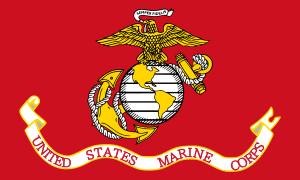
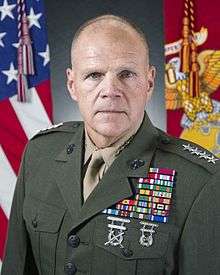

.jpg)
